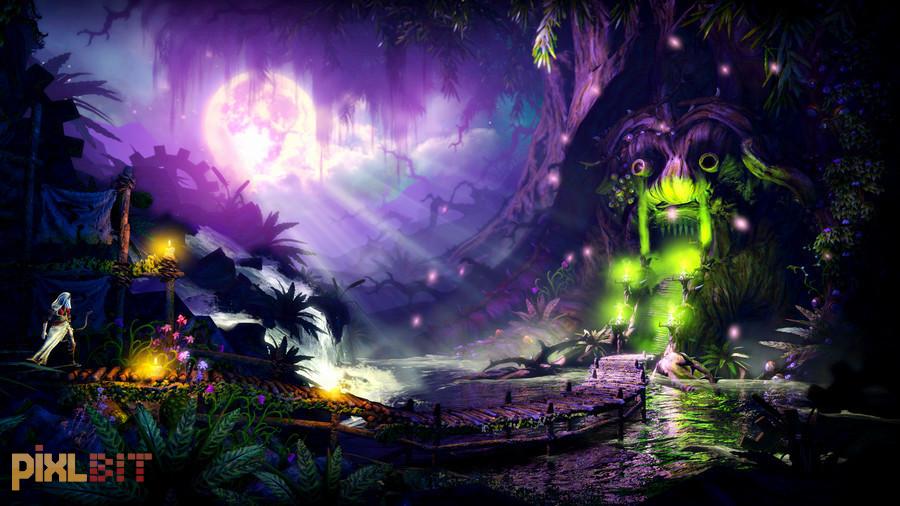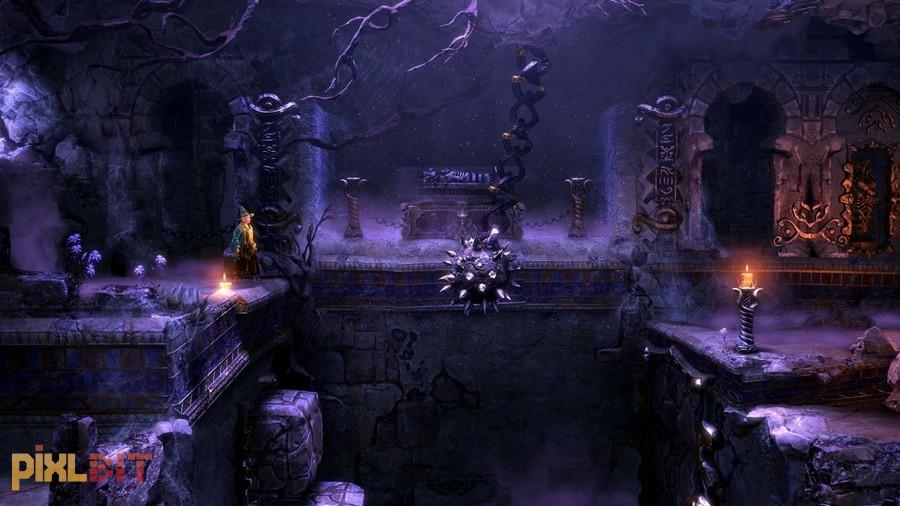
Like many games featured in the Wii U launch, Trine 2 saw release on other platforms at a much earlier point. However, with its release on Nintendo’s new hardware it seems to have found its true home. Through combined use of the Wii U GamePad’s touch screen and its traditional controls, players have the most effective means of interacting with this beautiful game yet. With the addition of the Goblin Menace expansion and the exclusive Dwarven Caverns level, there’s little question that the Wii U edition of the game is the one to get.
While Trine 2 features its fair share of combat, at its core it’s really a puzzle-platformer. As Jesse Miller explained in his review of the original release, the game’s puzzle elements are a bit rough and many of the puzzles can be solved through brute force, and this is especially true given the much improved controls for Amadeus the wizard. The GamePad makes it very simple to spawn boxes and move them around. Quickly creating boxes and jumping on them can make quick work of many of the puzzles, especially earlier in the game.

Shooting arrows with Zoya, the thief, can be much easier as well. Pointing and holding on the GamePad makes it quick and easy to shoot off an arrow without having to do much real aiming. The same goes for hurling Pontius the knight’s battle hammer. At times it’s more convenient to take to the joystick, but having that flexibility is the real key.
Despite the improvements that the GamePad brings, movement can still be a bit finicky, often resulting in missed jumps when you’re trying to get around quickly. Pontius’ combat can also be quite cumbersome, which fits his hulking design, but can also occasionally be annoying, especially when you’re quickly trying to switch between the battle hammer and the sword to properly attack your foes.
Problems aside, the real magic of Trine 2 is experimenting with and exploring the surroundings. In every nook and cranny there’s something hidden, whether it be a treasure chest or simply a cache of potions for buying new abilities. Using Zoya’s grappling hook is consistently fun, as is the kitesail shield for Pontius, when you eventually earn enough points to buy it.

By the end of the main quest, it’s likely that you’ll be sick of the fairly consistent and similar levels; however, it’s worth pressing on through the six Goblin Menace levels. Not only are they exclusive to the Wii U in the console space, but they’re also the most inventive and creative levels in the game. Instead of the familiar jungle, ice, and cave type levels, you’re transported to a desert, the belly of a sandworm, and even up into the clouds. Each level is memorable and much improved over the core experience.
Now, if you already own Trine 2 on a different platform and just want to check out the new content, you’re going to upset to learn that you must beat the entire game to unlock the Goblin Menace levels. Even worse, the exclusive Wii U level requires you to find all of the missing pieces of the map through the Goblin Menace levels, which is no easy task. For this reason, Trine 2: Director’s Edition is best experienced by newcomers to the title only.
With well over 15 hours of gameplay, Trine 2 represents an incredible value. Surely completing all of the various goals found in the exceptionally long levels will tack on at least 5 more hours, if not longer. If you choose to tackle the game in co-op you can either play locally with two others, or hop online for a smooth game with a friend or stranger.

Despite dragging at various times through the main quest, I enjoyed my time with Trine 2, especially when I finally reached the Goblin Menace portion of the game. If you enjoy 2D puzzle platformers and can overlook the occasionally repetitious gameplay, Trine 2: Director’s Cut is a great value and an almost consistently enjoyable experience.
Review Policy
In our reviews, we'll try not to bore you with minutiae of a game. Instead,
we'll outline what makes the game good or bad, and focus on telling you whether
or not it is worth your time as opposed to what button makes you jump.
We use a five-star rating system with intervals of .5. Below is an outline of
what each score generally means:

All games that receive this score are
standout games in their genre. All players should seek a way to play this game.
While the score doesn't equate to perfection, it's the best any game could conceivably do.

These are above-average games that most players should consider purchasing. Nearly
everyone will enjoy the game and given the proper audience, some may even love these
games.

This is our middle-of-the-road ranking. Titles that receive three stars may not make
a strong impression on the reviewer in either direction. These games may have some
faults and some strong points but they average out to be a modest title that is at
least worthy of rental for most.

Games that are awarded two stars are below average titles. Good ideas may be present,
but execution is poor and many issues hinder the experience.

Though functional, a game that receives this score has major issues. There are little
to no redeeming qualities and should be avoided by nearly all players.

A game that gets this score is fundamentally broken and should be avoided by everyone.















Comments